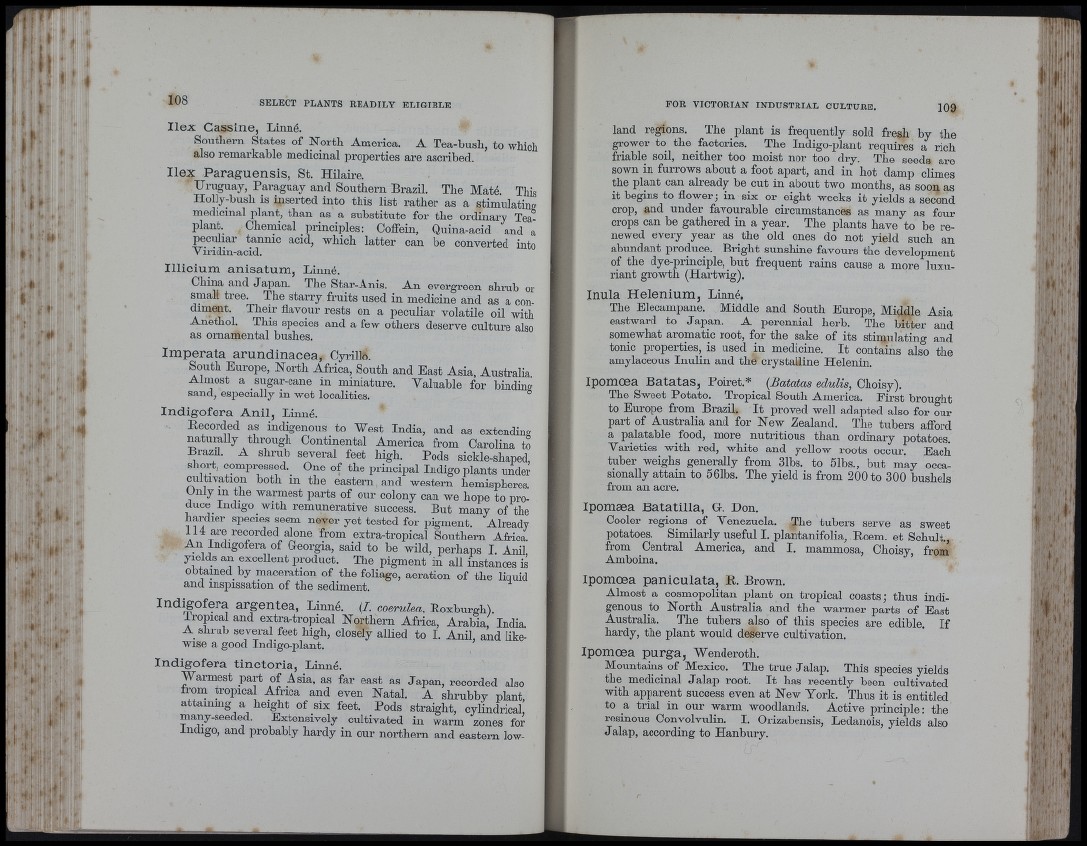
I I'i
■ Jüll
Ilex Cassine, Linné.
Southern States of North America. A Tea-bush, to which
also remarkable medicinal properties are ascribed.
Ilex Paraguensis, St. Hilaire.
Uruguay, Paraguay and Southern Brazil. The Maté. This
Holly-bush is inserted into this list rather as a stimulating
medicmal plant, than as a substitute for the ordinary Tea
plant. Chemical _ principles : Coffein, Quina-acid and a
peculiar tannic acid, which latter can be converted into
viridin-acid.
Illicium anisatum, Linné.
China and Japan. The Star-Anis. An evergreen shrub or
small tree. The starry fruits used in medicine and as a condiment.
Their flavour rests on a peculiar volatile oil with
Anethol. This species and a few others deserve culture also
as ornamental bushes.
Imperata arundinacea, Cyrillo.
South Europe, North Africa, South and East Asia, Australia
Alinost a sugar-cane in miniature. Valuable for binding
sand, especially in wet localities.
Indigofera Anil, Linné.
Recorded as indigenous to West India, and as extendin<j
naturally through Continental America from Carolina to
Brazil. A shrub several feet high. Pods sickle-sbaped,
short, compressed. _ One of the principal Indigo plants under
cultivation both in the eastern and western hemispheres
Only in the warmest parts of onr colony can we hope to produce
Indigo with remunerative success. But many of the
hardier species seem never yet tested for pigment. Already
114 are recorded alone from extra-tropical Southern Africa.
An Indigofera of Georgia, said to be wild, perhaps I. Anil,
yields an excellent product. The pigment in all instances is
obtained by maceration of tbe foliage, aeration of the liquid
and inspissation of the sediment.
Indigofera argentea, Linné. (/, coeruUa, Roxburgh).
Tropical and extra-tropical Northern Africa, Arabia, India.
A shrub several feet high, closely allied to I. Anil, and likewise
a good Indigo-plant.
Indigofera tinctoria, Linné.
Warmest part of Asia, as far east as Japan, recorded also
from tropical Africa and even Natal. A shrubby plant,
attainmg a height of six feet. Pods straight, cylindrical
many-seeded. Extensively cultivated in warm zones for
indigo, and probably hardy in our northern and eastern lowland
regions. The plant is frequently sold fresh by the
grower to the factories. The Indigo-plant requires a rich
friable soil, neither too moist nor too dry. The seeds are
sown in furrows about a foot apart, and in hot damp climes
the plant can already be cut in about two months, as soon as
it begins to flower; in six or eight weeks it yields a second
crop, and under favourable circumstances as many as four
crops can be gathered in a year. The plants have to be renewed
every year as the old ones do not yield such an
abundant produce. Bright sunshine favours the development
of the dye-principle, but frequent rains cause a more luxuriant
growth (Hartwig).
Inula Helenium, Linné.
The Elecampane. Middle and South Europe, Middle Asia
eastward to Japan. A perennial herb. The bitter and
somewhat aromatic root, for the sake of its stimulating and
tonic properties, is used in medicine. I t contains als'o the
amylaceous Inulin and the crystalline Helenin.
Ipomoea Batatas, Poiret.* {Batatas edulis, Choisy).
The Sweet Potato. Tropical South America. Eirst brought
to Europe from Brazil. I t proved well adapted also for our
part of Australia and for New Zealand. The tubers afford
a palatable food, more nutritious than ordinary potatoes.
Varieties with red, white and yellow roots occur. Each
tuber weighs generally from 31bs. to 51bs., but may occasionally
attain to 561bs. The yield is from 200 to 300 bushels
from an acre.
Ipomæa Batatilla, G. Hon.
Cooler regions of Venezuela. The tubers serve as sweet
potatoes. Similarly useful I. plantanifolia, Roem. et Schult.,
from Central America, and I. mammosa, Choisy, from’
Amboina.
Ipomoea paniculata, R. Brown.
Almost a cosmopolitan plant on tropical coasts; thus indigenous
to North Australia and the warmer parts of East
Australia. The tubers also of this species are edible. I f
hardy, the plant would deserve cultivation.
Ipomoea purga, Wenderoth.
Mountains of Mexico. The true Jalap. This species yields
the medicinal Jalap root. I t has recently been cultivated
with apparent success even at New York. Thus it is entitled
to a trial in our warm woodlands. Active principle: the
resinous Conyolvulin. I. Orizabensis, Ledanois, yields also
Jalap, according to Hanbury.
Mi
/!■ I
(